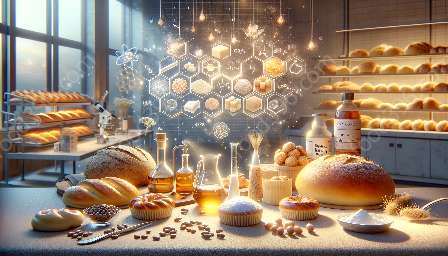Baking is not just a culinary art but also a science that involves fascinating chemical reactions. In this topic cluster, we will delve into the world of baking chemistry, focusing on acid-base reactions, leavening agents, and their impact on the science and technology of baking.
Understanding Acid-Base Reactions in Baking
Acid-base reactions play a crucial role in the chemical processes that occur during baking. When an acidic ingredient, such as buttermilk or cream of tartar, interacts with a basic ingredient, such as baking soda or baking powder, a chemical reaction takes place, resulting in the production of carbon dioxide gas.
This release of carbon dioxide gas causes the dough or batter to rise, giving the baked goods their characteristic light and airy texture. Additionally, acid-base reactions contribute to the development of flavor and the browning of the crust in baked products.
The Role of Leavening Agents
Leavening agents are substances that are used to introduce air or gas into a dough or batter, leading to its expansion and rising during the baking process. In the context of acid-base reactions, leavening agents, such as baking soda and baking powder, serve as the key catalysts that initiate and facilitate the production of carbon dioxide gas.
Baking soda, also known as sodium bicarbonate, is a base that requires an acidic ingredient to react with in order to release carbon dioxide. On the other hand, baking powder contains both an acidic component and a base, allowing it to undergo a chemical reaction independently, which makes it a convenient leavening agent for recipes that do not contain acidic ingredients.
Chemical Reactions and Baking Science
Chemical reactions in baking encompass a wide array of processes that contribute to the overall quality and characteristics of the final baked products. In addition to acid-base reactions and the action of leavening agents, various chemical reactions take place during mixing, fermentation, and heat exposure in the oven.
The Maillard reaction, for instance, is a chemical reaction that occurs between amino acids and reducing sugars in the presence of heat, resulting in the browning and development of complex flavors in baked goods. Understanding these chemical reactions is essential for bakers and food scientists to manipulate and control the outcomes of their baked products.
Baking Science & Technology: Exploring Innovations in Baking Chemistry
The field of baking science and technology is constantly evolving, with researchers and professionals seeking innovative ways to enhance the quality, efficiency, and sustainability of baking processes. Advances in food chemistry and technology have led to the development of novel leavening agents, such as enzyme-based and microorganism-based alternatives, offering bakers new opportunities to explore the potential of acid-base reactions in baking.
Moreover, technological developments have enabled the precise control of baking parameters, such as temperature, humidity, and mixing techniques, allowing for the optimization of chemical reactions and the customization of product characteristics. These advancements are reshaping the landscape of baking, providing unique opportunities for creativity and improvement in the industry.
Through this topic cluster, you have gained insights into the intricate world of baking chemistry, from the fundamental principles of acid-base reactions and leavening agents to the broader implications of chemical reactions in the realm of baking science and technology. Whether you are a home baker, a culinary enthusiast, or a professional in the baking industry, understanding the chemistry behind baking is essential for mastering the art and science of creating delectable baked goods.


